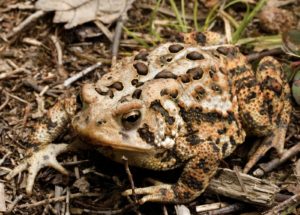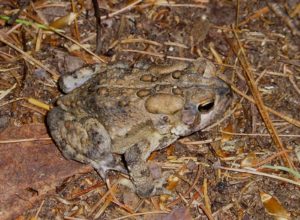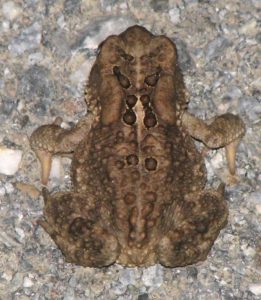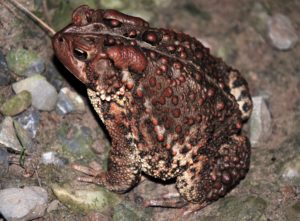Anaxyrus americanus
Identification
The American Toad is one of Vermont’s two toad species. Toads can be distinguished from other frogs in Vermont by their dry and bumpy skin and by the long oval parotoid glands (one behind each eye). The American Toad has at least one large wart in each one of the large black spots found along its back. The underside of the toad is white with black specks. Adults are 2-3½ inches long.
The American Toad’s call is a long trill that lasts up to 15 seconds. It is generally heard in warm weather from April to July, with the beginning of May being the peak calling time. Toads generally do not start calling until the nighttime temperatures warm to above 60 degrees Fahrenheit.
They lay their eggs in long strings. The females can produce thousands of eggs that can be found from early May to mid August.
Get more detailed identification and life history information by downloading the chart here.
You can learn more about this species and see some video footage by checking out this clip from our Rattlers, Peepers & Snappers DVD.
Range/Habitat
[ click image to zoom | download printable PDF ]

[ click image to zoom | download printable PDF ]
American Toads are found throughout Vermont and are one of our most common amphibian species.
Status
This species has a state natural heritage rank of S5 (common). Please report sightings of this species in Vermont if you have not reported them within the last five years from a given location. Any natural history observations (feeding, migrations, road crossing areas, early or late season appearance, abnormalities, etc.) are appreciated. Photographs are always helpful, particularly if your report is the first report of this species from a town.
Additional Photos
More Info
Anaxyrus americanus was Bufo americanus until 2008.
- Anaxyrus americanus at Animal Diversity website
- Anaxyrus americanus at Amphibiaweb
- Listen to toad calls
at Animal Diversity (.mp3 and .wav format)
at Frog Quiz
or at the Yale Peabody Museum (.wav format)
Species summary written by Ariel K. Mck. Burgess.








